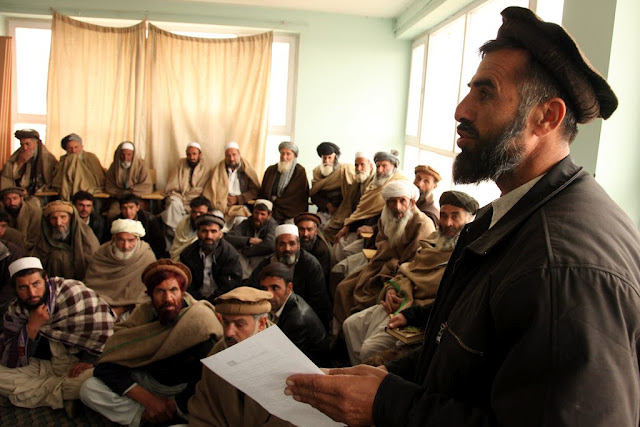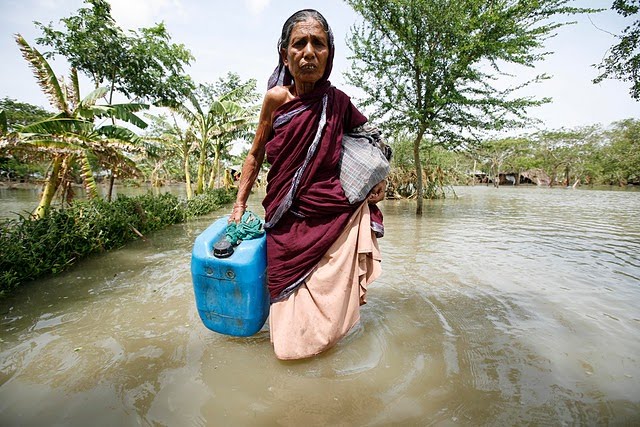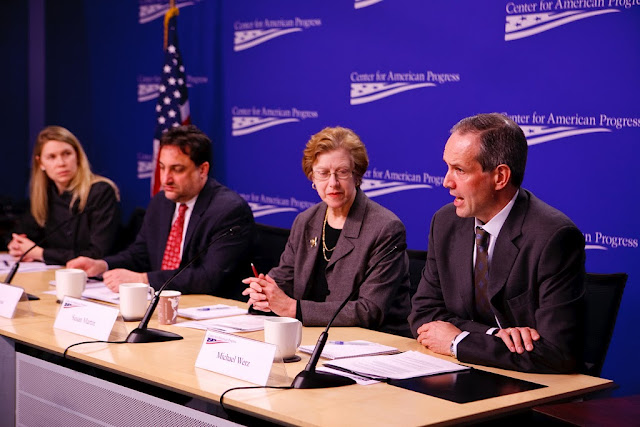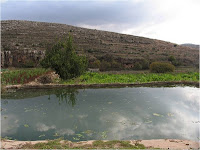-
Copper in Afghanistan: Chinese Investment at Aynak
›Will new investments by the Metallurgical Corporation of China (MCC) in the Aynak copper mine break Afghanistan out of its poverty trap? Will future revenues from the subsoil assets in Logar Province bring peace and stability to the ongoing conflict?
The U.S. Institute of Peace brought together expert panelists to discuss the pitfalls and possibilities related to the Aynak contract. Discussed were current uncertainties in investment plans, future risks related to mine operations, how the various stakeholders of the Aynak project can be more engaged in the process, as well as the planned reinvestment of economic benefits within the broader economy.
Alone, the Aynak Copper Mine’s multi-billion dollar reserves will not bring about security, but its success can be a gateway to future development. According to Lorenzo Delesgues, co-director of Integrity Watch Afghanistan, however, there is also a chance that this conflict-ridden region will find the mines a catalyst for more disputes. According to Delesgues, the potential negative impacts on the surrounding communities and the environment “can be exacerbating factors that might create even more insecurity than what you already have in that area.”Delesgues suggested that certain programmatic alterations needed to be considered by the MCC and the Afghan government to leverage local sustainable economic development beyond Aynak. For Delesgues, local communities need better information about mining’s environmental and employment impacts to improve their decision-making abilities, as many common social and environmental protections are lacking from the current MCC mining plans and activities. An environmental impact assessment, for example, has not yet been carried out, leading to concerns that on-going exploration activities may harm the local environment and downstream populations. To prevent future disputes, Integrity Watch Afghanistan recommends strengthening project monitoring processes and greater public communication and consultation with key stakeholders.
Gary McMahon, senior mining specialist at the World Bank, believes that Afghanistan is in a good position to benefit from the Aynak copper mines. Local employment generation and the MCC’s stated commitment to provide educational, health, and housing services to employees all offer promise for development. There are also contractual obligations for a power plant that will supplement a portion of Kabul’s current demand and the construction of a railway system through Afghanistan, which will extend from China to Tajikistan, and strengthen existing Afghan trade networks.
While the royalty rates established by the Afghan government in the Aynak contract on future mining revenue streams are unprecedented in the mining sector, McMahon fears that the revenue will solely follow international aid flows. “If all that happens is that fiscal revenues [from Aynak] replace foreign aid, the impacts are going to be way less,” says McMahon.
McMahon suggests that, moving forward, the Ministry of Mines and the National Environmental Agency’s capacities for monitoring and evaluation must be improved and strengthened. There also needs to be assurance that the local population gets a “fair share” of jobs and other opportunities, along with continuous consultation of the impact the mines are having on their social and environmental conditions.
In his concluding statements, Ishaq Nadiri, professor of economics at New York University and former senior economic advisor to Hamid Karzai, cautioned the audience about the weight that economics plays in the overall outcome of the Aynak Copper Mine. According to Nadiri, the objective in establishing the Aynak contract was to maximize national benefits. Nadiri offered hope that “the lack of security…[which] emanates from the highly chronic poverty of the country,” could find promising solutions in the wealth of Aynak.
Drafted by Michelle Neukirchen, edited by Julien Katchinoff.
Photo Credits: “River and Mountains of Logar,” courtesy of flickr user AfghanistanMatters and “Logar Province Shura,” courtesy of flickr user IsafMedia. -
A Forecast of Push and Pull: Climate Change and Global Migration
›March 10, 2010 // By Julien Katchinoff
“As we …talk about the interconnections between climate change and migration we need to look at the interconnections in a way that understands what’s positive about the processes of migration and what’s problematic,” said Susan Martin, Herzberg Professor of International Migration at Georgetown University, during a recent event on climate and migration at the Center for American Progress.
Susan Martin joined Cynthia Brady, senior conflict advisor for the Office of Conflict Management and Mitigation at USAID and David Waskow, director of the Climate Change Program at Oxfam America, to identify the catalysts for future population flows, offer pragmatic policy solutions, and discuss work to be done on the ground.
While reminding the audience that climate-induced migration will tend to follow already existing patterns, Susan Martin broadly outlined four major intersections between migration and climate change impacts:
“Slow” Migration Pressures:- Drought or desertification resulting in a loss or depreciation of livelihoods.
Result: Push working family members to migrate to domestic or international urban centers. - Rising sea levels damaging fishing and agriculture opportunities.
Result: Migration to inland regions to reduce future risk.
“Rapid” Migration Pressures:- Intensification of natural disasters and damage to infrastructure.
Result: The coping costs increase to the point where they push large numbers of people to leave their homes. Most individuals migrate internally. Of the four intersections, this is currently the most common. - Threats to the availability of food, water, and other natural resources.
Result: Low or high intensity conflict, leading to migrations. The short timeframes and potentially large numbers of migrants involved make this driver the most problematic. Differing degrees of internal political stability are factors that can interfere for better or worse.
Yet these relationships are not without controversy. “Environmentalists have tended to see the issue of migration as a way of getting attention to mitigation and have often talked about migration in very alarmist terms,” Martin said. “Migration experts, on the other hand, have been very skeptical about the interconnection.” Instead, they have argued that other push and pull factors outside of climate are much more significant to the migration calculation.

Operating from the perspective that migration itself is an adaptation failure, David Waskow outlined several strategies that Oxfam deploys to help communities copewith uncertain futures:
- Building climate resilience and developing adaptation strategies: Proactive approaches are essential, as agencies and communities can address future threats with disaster planning and creating early-warning systems.
- Managing risk: The establishment of micro-insurance projects can cushion vulnerable populations against unexpected economic shocks.
- Resettling communities: The movement of rural populations to urban areas could result in tensions over land use and strains on urban governance and carrying capacities. As a result, this approach is left as a last recourse.
Brady, though in agreement with Waskow concerning climate change’s threat to livelihoods and its role as a catalyst for conflict, suggested that there may be positive opportunities for managing climate risks. “The environment can and does provide an essential and effective platform for dialogue, communication, and confidence-building around shared interests,” Brady said. “It may be that certain conflicts actually lend themselves to the use of climate-related collaboration as a mechanism to resolve conflict or reduce tension between parties,” she said.
Climate-related projects at the community-level, from adaptive early-warning systems to mitigating carbon storage schemes, hold the possibility to bring groups together in cooperative projects, build confidence, and defuse existing tensions. Transparent and participatory management of new investments may also increase trust in local and national governments with whom trust was previously lacking. While forestalling crises in the future, adaptation projects also hold the potential to unlock opportunities for peacebuilding and conflict resolution today.
Photo Credits: Photo 1 courtesy Oxfam America. Photo 2 courtesy Center for American Progress. - Drought or desertification resulting in a loss or depreciation of livelihoods.
-
World Bank Data Visualization
›Yesterday Google and the World Bank expanded their data-sharing partnership, first initiated last fall, to include a subset of 54 World Development Indicators and enhanced visualization tools. Users can now interact with data—spanning a range of both environmental and population statistics, from forest coverage area to contraceptive prevalence—using line graphs, bar graphs, maps, and xy-plots. Each option also offers users the ability to follow the data changes over time.
An alternative to Google’s Public Data Explorer is the World Bank’s Data Visualizer. Although limiting data output to an xy-plot, the customization options go beyond those offered by the Public Data Explorer and achieve a good balance between flexibility and ease of use. Table colors and groupings are fully customizable, scales are adjustable, and the chart can be quickly printed or exported as a jpeg. -
Urbanization and Deforestation
›The journal Nature Geoscience recently published a study comparing the impacts of rural and urban population growth on deforestation. “Deforestation Driven by Urban Population Growth and Agricultural Trade in the Twenty-First Century” finds deforestation is positively correlated with urban population growth and agricultural exports to international markets. In rural areas, however, the link between deforestation and population growth was absent, indicating that urbanization and agricultural export-oriented economies were the primary drivers for forest loss. The study concludes that, rather than focusing on the activities of rural populations, deforestation reduction efforts should target “industrial-scale, export-oriented agricultural production, concomitant with efforts to increase yields in non-forested lands.” (SUBSCRIPTION ONLY)
“The Population, Agriculture, and Environment Nexus in Latin America: Country-Level Evidence from the Latter Half of the Twentieth Century,” a study published in the journal Population & Environment, examines the relationship between land use and population shifts in Latin America between 1961 and 2001. The paper focuses on deforestation, which was found to be spurred by both Malthusian and Boserupian demographic drivers. It concludes that population growth, urban consumption patterns, and land-use constraints will continue to pose challenges for Latin American policymakers trying to achieve a sustainable equilibrium. (SUBSCRIPTION ONLY) -
Green Objections to the Green Line: A Struggle for a Shared Environment in the Middle East
›March 4, 2010 // By Julien KatchinoffAn emerging coalition in Israel dramatically illustrates how common environmental concerns can create unexpected partnerships across difficult political barriers. Through programs initiated by Friends of the Earth Middle East, the Israeli and Palestinian residents of Wadi Fukin and Tzur Hassadah (see inset map) have joined together to oppose the construction of a planned security barrier between their two communities.
View Good Water Neighbors in a larger map
The barrier, an element of the Israeli Green Line, threatens to disrupt karstic springs that support traditional agriculture in the Fukin valley. One third of the Israeli residents of Tzur Hadassah petitioned to halt construction, reports Israeli newspaper Haaretz.
“The Israeli community understood that instead of providing them with security, the fence would harm the springs and lands of the village, and will rob the Palestinian farmers of their livelihood and arouse hatred toward their Israeli neighbors,” Friends of the Earth Middle East (FoEME) Director Gidon Bromberg told Haaretz.
On February 24th, Israelis and Palestinians from both communities met to organize their response to the construction of the separation barrier, including preparing to petition to the Israeli High Court of Justice.
“The case of Wadi Fukin is special, because it is the first time that the resistance of the residents is not based on human rights allegations. Objections here are from an environmental organization,” FoEME attorney Michael Sfard told NRG news. Since 2001, FoEME’s Good Water Neighbors project has helped divided communities come together over shared natural resources. By collaborating with community members to improve their water situation, the organization encourages sustainable water management through information sharing, dialogue, and cooperative ventures. While the majority of the communities share common surface water sources, including the Jordan and Zomar rivers, some, as with Wadi Fukin and Tzur Hassadah, rely on common underground aquifers.
Since 2001, FoEME’s Good Water Neighbors project has helped divided communities come together over shared natural resources. By collaborating with community members to improve their water situation, the organization encourages sustainable water management through information sharing, dialogue, and cooperative ventures. While the majority of the communities share common surface water sources, including the Jordan and Zomar rivers, some, as with Wadi Fukin and Tzur Hassadah, rely on common underground aquifers.
This “natural interdependence,” says Bromberg, helps to create trust and solve problems facing both communities.
Photo: Courtesy Friends of the Earth Middle East -
Visualizing Natural Resources, Population, and Conflict
›Environmental problems that amplify regional security issues are often multifaceted, especially across national boundaries. Obtaining a comprehensive understanding of the natural resource, energy, and security issues facing a region is not fast or easy.
Fortunately, the Environment and Security Initiative (ENVSEC) has created highly informative, easy-to-understand maps depicting environmental, health, population, and security issues in critical regions.
Published with assistance from the United Nations GRID-Arendal, these maps offer policymakers and the public a snapshot of the complex topography of environmental security hotspots in Central Asia, Eastern Europe, Southeastern Europe, and the Southern Caucasus.
Some that caught our eye:
• Environmental Issues in the Northern Caspian Sea: Overlaying environmental areas and energy production zones, this map finds hydrocarbon pollution in sturgeon spawning grounds, seal habitats in oil and gas fields, and energy production centers and waste disposal sites in flood zones.
• Water Withdrawal and Availability in the Aral Sea Basin: Simple and direct, this combination map and graph contrasts water usage with availability in Turkmenistan, Uzbekistan, and Kazakhstan—which stand in stark comparison to the excess water resources of Tajikistan and Kyrgyzstan.
• Environment and Security Issues in Belarus: In addition to noting the parts of the country with poor water quality and potassium mining, the map also delineates wildfires that occurred in areas contaminated by the Chernobyl explosion, thus threatening downwind populations.
Maps: Illustrations courtesy of the Environment & Security Initiative. -
The Diane Rehm Show Tackles Water Challenges With ECSP Director Geoff Dabelko
›March 3, 2010 // By Michelle NeukirchenHow is water shaping geopolitics in the 21st century? Is it an underlying factor for state failure and social conflict, or can it drive peace and cooperation? How will climate change reshape global water resources?Recently, on WAMU’s “The Diane Rehm Show,” ECSP Director Geoff Dabelko, author Steven Solomon, and the World Bank’s Julia Bucknall came together to discuss the history, politics, economics, and future of water.
“Climate change exacerbates the water crisis in very severe ways because it manifests itself through water —through floods, droughts, and melting glaciers,” said Solomon.
The World Bank’s Julia Bucknell highlighted climate change projections that indicate average precipitation increases are likely, mostly in the global North. “It is the poorer countries that show up red on the maps with a reduction in precipitation,” she said.
By compounding failing states’ limited capacity to secure existing water supplies for agriculture, sanitation, and human consumption, decreasing precipitation will result in further intensification of global public health and food security crises.
“We need to improve the existing productivity of the water we’ve got,” said Solomon. “We need to use it more efficiently and fairly in a way that protects the ecosystems.”
Countries such as Australia, Israel, and China are leading the way: even under arid conditions, they use innovative methods to remain productive. In Australia, a new regime allows water rights to be traded, even over cellphones, while China established a credit-based system for individual farmers by using remote sensing technology based on NASA data.
Governments are under pressure to address climate change directly, while managing vexing local and regional challenges. “Our political institutions and our political leaders must not deal with the short term and pretend things will go back to a state of normalcy, but [should] progressively and proactively shape and reshape the institutions,” said Dabelko. Countries with traditionally contentious relationships have cooperated to solve common water problems. The Financial Times recently reported on an agreement between China and India to jointly assess trends in Himalayan glacier and snow melt.
Countries with traditionally contentious relationships have cooperated to solve common water problems. The Financial Times recently reported on an agreement between China and India to jointly assess trends in Himalayan glacier and snow melt.
“There are prospects for tensions,” said Dabelko of the Himalayas, “but quite frankly, water is difficult to [obtain] through war. It’s hard to pick it up and take it home.”
To listen to the full audio recording, click here.
Photo: Just Add Water, Courtesy of Flickr Member MΛЯK
Photo: Melting Glacier at Jokuldalur, Iceland 2, Courtesy of Flickr Member, ChrisGoldNY -
Healing the Rift: Mitigating Conflict Over Natural Resources in the Albertine Rift
›March 2, 2010 // By Dan Asin Conservation practitioners realize they must deal with conflict but often lack the training to do so, says Dr. Andrew Plumptre, director of the Wildlife Conservation Society’s (WCS) Albertine Rift Program. Moreover, they don’t realize their conservation efforts—by restricting access to resources or creating new burdens, costs, and risks for communities—are at times directly responsible for spawning new conflicts where none existed before.
Conservation practitioners realize they must deal with conflict but often lack the training to do so, says Dr. Andrew Plumptre, director of the Wildlife Conservation Society’s (WCS) Albertine Rift Program. Moreover, they don’t realize their conservation efforts—by restricting access to resources or creating new burdens, costs, and risks for communities—are at times directly responsible for spawning new conflicts where none existed before.
In a recent presentation—Healing the Rift: Mitigating Conflict Over Natural Resources in the Albertine Rift, sponsored by WCS and the Africa Biodiversity Collaborative Group—Plumptre used his work with WCS in the Albertine Rift as a launch pad to discuss how conservation practitioners can work to mitigate conflict.
Achieving “Conflict-Sensitive Conservation”
“Conflict-sensitive conservation,” as outlined in an International Institute for Sustainable Development‘s practitioners’ manual developed in conjunction with WCS, is a multi-step process:- Identify—What are the area’s current or potential conflicts?
- Prioritize—Which conflicts are the most serious?
- Target—Which high-risk conflict does my organization possess the capacity to address?
- Analyze—What are the causes and effects of conflict? Who are the stakeholders, what are the relationships between them, and which should we seek to engage?
- Design & implement solutions—With what strategy should the conflict be approached? At which point in the conflict cycle should we seek to intervene?
- Monitor—Continue to watch the area for new developments.
Plumptre’s fieldwork on the DRC’s Virunga National Park is one of the case studies in Renewable Natural Resources: Practical Lessons for Conflict-Sensitive Development, recently published by the World Bank. Conflict in the park began in 1996, when an influx of internally displaced persons from the war in the DRC poured into the area, placing severe strains on the park’s fish, wildlife, timber, and agricultural resources.
In 2006, Plumptre and his WCS colleagues entered Virunga and identified four challenges they could best address:- Overfishing on Lake Edward
- Military poaching
- Park encroachment
- Conflict with displaced Ugandan pastoralists
- To combat overfishing, WCS helped villages establish sustainable targets and implement internal policing mechanisms
- To curtail encroachment and poaching by the military and those living in the greater Virunga National Park area, WCS trained Congolese Park Authority (ICCN) staff in enforcement and monitoring techniques, established channels of communication with military commanders, and engaged in general and targeted environmental educational campaigns.
- To relieve resource pressures from the presence of Ugandan pastoralists, WCS worked with the Congolese and Ugandan governments to ensure pastoralists could safely and freely return to Uganda to settle elsewhere.
Beyond Virunga National Park
Since completing their project in 2007, Plumptre and his team have established similar projects in Kahuzi-Biega National Park, the Itombwe Massif, and Misotshi-Kabogo. Now, however, they are working to prevent conflicts before they take root. WCS has guided communities in the Misotshi-Kabogo area to work together to petition the Congolese government to turn their territory into the DRC’s 8th national park.
Climate change is predicted to spur local, often intra-state or regional, migrations in response to droughts and flooding. Could these migrations lead to similar resource conflicts in the future? The rate of migration, governance and carrying capacities of the absorbing communities, and economic status of the migrants will all come in to play. In cases where conflict might result, Plumptre’s work successfully demonstrates that “conflict-sensitive conservation” should have a place in the peacebuilders’ toolkit.
 A Publication of the Stimson Center.
A Publication of the Stimson Center.




 Since 2001, FoEME’s
Since 2001, FoEME’s 



 Countries with traditionally contentious relationships have
Countries with traditionally contentious relationships have 


